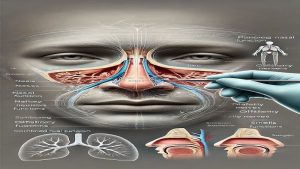Comprehensive review
Introduction
The nose as a vital member in the human respiratory and sensory system plays a key role in breathing, smell, air temperature regulation and humidity.. Any disturbance in normal nasal function can lead to serious problems in one's quality of life. Nasal surgeries, especially hybrid surgeries such as rhinoplasty (Correcting the appearance of the nose) And the turbine (Nasal tentacles modification), In addition to improving beauty, they should be focused on maintaining or improving normal nasal function. In this article from the site of Dr. Behnam Khorrami (Isfahan nose surgeon _ Jaw surgeon of Isfahan)The importance of maintaining nasal function in combined surgeries and strategies to prevent functional complications.
The vital role of the nose in normal body functioning
1. Respiratory function
Nose is the first route of air entry into the respiratory system. The nose's main roles in the breathing process include the following:
Air filtration: Hair and nose mucosa trap external particles, dust and pathogens.
Warm and moisturize air: The rich vascular grid and the mucosal glands in the nose bring air to body temperature and moisturize.
Adjusting airflow: Nasal tentacles (Turbines) By adjusting the air passage, they distribute it properly in the lungs..
2. Smell performance
The olfactory receptor cells on the roof of the nasal cavity detect the odor molecules and send it to the brain.. Maintaining this performance, especially in people who depend on the quality of the sense of smell (Like chefs), Is very important.
3. Defensive performance
Mucus secretion and activity (cilia) It eliminates the pathogens and external particles from the respiratory tracts.
Nose with the production of nitric oxide (NO)Helps dilate pulmonary vessels and improve oxygenation.
The goals of nasal composite surgery
1. ÿ±ğåŸÜŸàŸæŸÑÿßÿ≥ÿ™ğå (Rhinoplasty)
ÿ±ğåŸÜŸàŸæŸÑÿßÿ≥ÿ™ğå Usually with the aim of correcting the appearance of the nose (Decrease or increase size, deflection and structural abnormalities) Done. However, this surgery should not cause obstruction or disorder in the respiratory tract.
2. Engineer (Turbinectomy or Turbinoplasty)
Turbine with the aim of shrinking or adjusting the turbines (Nasal tentacles) Is done to improve airflow. If this action is too aggressive, it may lead to “Empty nose syndrome (ENS)” Be associated with dryness, burning and feeling of false obstruction.
3. ÿ≥Ÿæÿ™ŸàŸæŸÑÿßÿ≥ÿ™ğå (Septoplasty)
Correction of deviated nasal septum (سپتوم) Usually performed to improve respiratory function. Septoplasty composition with rhinoplasty and turbine requires high skill in maintaining structural and functional balance of the nose.
Challenges to maintain nasal function in hybrid surgery
1. Nasal obstruction after surgery
Tissue swelling and scar formation may limit air passageway.
Excessive correction (Like severe shrinkage of turbines) May lead to a reduced airflow of inlet air.
2. Empty nose syndrome (ENS)
ENS occurs because of over -removal of turbines. This condition reduces feedback from air flow sensors and a sense of false obstruction..
Chronic dryness and impaired air humidity regulation are common symptoms of ENS.
3. Decreased sense of smell
Damage to the nerves of the olfactory or obstruction of the odor molecules to the receptors may reduce or destroy the sense of smell..
Surgery in the upper part of the nasal cavity, especially in the posterior area, increases the risk of damage to the olfactory function..
4. Nasal structural instability
Overdose of cartilage or bone may cause a drooping or dynamic obstruction of the respiratory pathway.
Carilary structure weakness causes the collapse of nasal valves (nasal valve) And difficult to breathe.
Solutions to preserve normal nasal function in combined surgeries
1. Pre -surgical planning
Complete evaluation of nasal structure through CT scans and rhinoanometrics (Measuring air flow).
Careful examination of respiratory and olfactory function.
Simulation of surgery with 3D software.
2. Protects vital nose structures
Maintaining lower turbines as much as possible.
Septom and turbine modification in a minimal and conservative manner.
Use of cartilage bonds (graft) To support the nose structure.
3. Precise and low -income surgical techniques
Use open or closed techniques based on individual conditions.
Prevent over -removal of cartilage and bone.
Preservation and reinforcement.
4. Post-surgery care
Use salt solutions to moisturize the mucosa.
Control of inflammation with anti -inflammatory drugs and steroids.
Evaluation of respiratory performance and smell in follow -up sessions.
Studies and clinical results
Studies have shown that:
In 1 % of patients, rhinoplasty and septoplasty improves the appearance and respiratory function simultaneously..
About 1-5 % of patients develop ENS after extensive turbulence.
Use of cartilage bonds (Especially from ear cartilage) In hybrid surgeries, it reduced the likelihood of structural collapse and respiratory obstruction by 5 %..

summary
Nasal Combined Surgery Although aimed at improving the appearance and function of the nose, any structural changes in the nose should be maintained by maintaining its normal function. (Breathing, smelling and adjusting airflow) to be accompanied. Pre -surgical evaluation, selection of conservative techniques, and post -surgical care play a key role in the long -term success of these surgeries..
Useful links:
Isfahan nose surgeon _ Jaw surgeon of Isfahan
Dr. Behnam Khorrami's page in the clinic 24 | Maxillofacial surgeon in Isfahan clinic 24 | Nose surgeon in Isfahan clinic 24
Dr. Behnam Khorrami, nose surgeon in Isfahan at Dr. Af | Maxillofacial surgeon in Isfahan at Dr. Af | Isfahan nose surgeon at Dr. Af